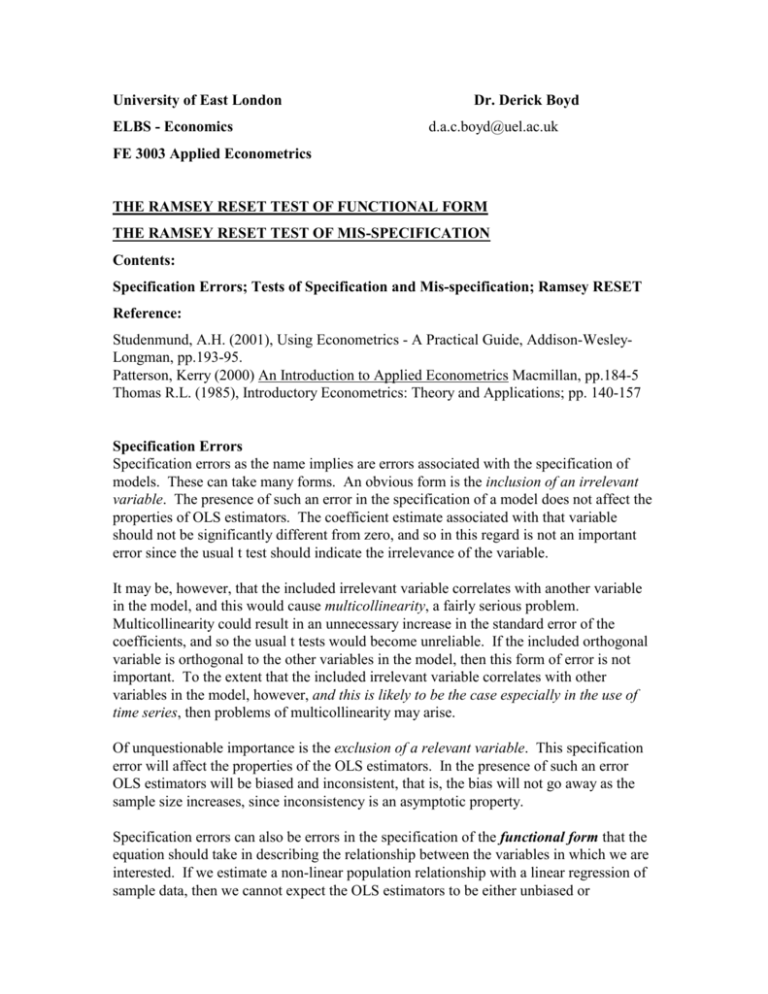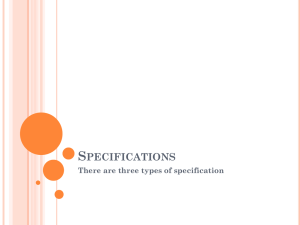Ramsey RESET Test: Applied Econometrics Lecture Notes
advertisement

University of East London ELBS - Economics Dr. Derick Boyd d.a.c.boyd@uel.ac.uk FE 3003 Applied Econometrics THE RAMSEY RESET TEST OF FUNCTIONAL FORM THE RAMSEY RESET TEST OF MIS-SPECIFICATION Contents: Specification Errors; Tests of Specification and Mis-specification; Ramsey RESET Reference: Studenmund, A.H. (2001), Using Econometrics - A Practical Guide, Addison-WesleyLongman, pp.193-95. Patterson, Kerry (2000) An Introduction to Applied Econometrics Macmillan, pp.184-5 Thomas R.L. (1985), Introductory Econometrics: Theory and Applications; pp. 140-157 Specification Errors Specification errors as the name implies are errors associated with the specification of models. These can take many forms. An obvious form is the inclusion of an irrelevant variable. The presence of such an error in the specification of a model does not affect the properties of OLS estimators. The coefficient estimate associated with that variable should not be significantly different from zero, and so in this regard is not an important error since the usual t test should indicate the irrelevance of the variable. It may be, however, that the included irrelevant variable correlates with another variable in the model, and this would cause multicollinearity, a fairly serious problem. Multicollinearity could result in an unnecessary increase in the standard error of the coefficients, and so the usual t tests would become unreliable. If the included orthogonal variable is orthogonal to the other variables in the model, then this form of error is not important. To the extent that the included irrelevant variable correlates with other variables in the model, however, and this is likely to be the case especially in the use of time series, then problems of multicollinearity may arise. Of unquestionable importance is the exclusion of a relevant variable. This specification error will affect the properties of the OLS estimators. In the presence of such an error OLS estimators will be biased and inconsistent, that is, the bias will not go away as the sample size increases, since inconsistency is an asymptotic property. Specification errors can also be errors in the specification of the functional form that the equation should take in describing the relationship between the variables in which we are interested. If we estimate a non-linear population relationship with a linear regression of sample data, then we cannot expect the OLS estimators to be either unbiased or 2 consistent. Let us suppose that the true population relationship between two variables is a quadratic function: Yt = + 1 Xt + 2 X2 t + t Then the specification of the sample relationship should be of the form: E[Yt] = + 1 Xt + 2 X2 t If a linear form is used: E[Yt] = + 1 Xt then this amounts to excluding the relevant variable X2, and consequently will be subject to the same omitted variable bias and inconsistency properties mentioned above. In some cases mis-specification of an equation can manifest itself in the form of autocorrelation. A fairly common form of mis-specification is dynamic mis-specification where the omitted variable or variables are lagged values of the dependent variable. This has given rise in recent years to the tests for autocorrelation such as the Durbin-Watson test, being increasingly interpreted as a test of mis-specification. In such cases, estimating the equation with an autoregressive routine such as Cochran & Orcutt, or Hildreth-Liu would be inappropriate. The appropriate response would be to search for the correct specification. Tests of Specification and Mis-specification The distinction between tests of specification and mis-specification resides on the alternative hypothesis in the test. A test of mis-specification such as the DW test we discussed above and the Ramsey RESET test are mis-specification tests because we test the null against an alternative that does not indicate what the correct specification should be. So the RESET test is a test of mis-specification, as is the DW test, that may indicate that there is some form of mis-specification but does not give any indication of what the correct specification should be. Ramsey Reset Test The test employed is a test a linear specification against a non-linear specification. The form of the test used may be illustrated as follows. Suppose the model first estimated is: Yi 1 2 X 2i 3i X 3i i=1, 2, … N [this is the regression estimate with the estimated coefficients]. The Reset test proceeds by estimating, Yi 1 2 X 2i 3i X 3i Yi 2 3 So, two regressions are estimated where the latter is the former with squared fitted values obtained from the first regression. Note that the squared fitted values introduces the nonlinearity into the specification. We will test for functional form with an F test. The null hypothesis is that the correct specification is linear. The alternative hypothesis is the correct specification is non-linear. We form the F test statistics as: F M ; N k 1 ( SSRYˆ SSRYˆ 2 ) / M SSRYˆ 2 /( N K ) ( SSRR SSRUR ) / M SSRUR /( N K ) Where SSRs are the sum of squared residuals for the respective regressions; M is the number of restrictions; N is the number of observations; K is the number of parameters estimated in the unrestricted equation. Note: we tend to use K to mean number of estimated parameters, this would mean that it is one greater than the number of explanatory variables because we also include the intercept parameter in the count. I noted in Studenmund (2001), however, that K is the number of explanatory variables. So we have to be aware of the definition that is being used. Essentially we have to be careful to ensure that the correct number for the degrees of freedom is used in the calculations. If the F test statistics is greater than the F critical value we reject the null hypothesis that the true specification is linear (which implies that the true specification is non-linear). If we are unable to reject the null then the results suggest that the true specification is linear and the equation passes the Ramsey Reset test. We may consider an example taken from Studenmund (2001: 193-5). The restricted equation for a demand for chicken function is: Yˆ 32.9 0.70 PCt 0.27YDt (8.33) (45.91) SSRR 185.66 N 44 Where Yˆ is the estimated demand for chicken; PC is the price of chicken; t is the time subscript; YD is disposable income. The unrestricted equation is estimated as: 4 Yˆ 23.80 0.59 PCt 0.36YDt 0.02Yˆt 2 0.007Yˆt 3 0.000055Yˆt 4 (0.34) (0.50) (0.29) (0.68) (1.02) SSRU 138.41 N 44 In this case the unrestricted functional form (specification) is to the fourth power ( a highly non-linear form) not merely a quadratic functional form as in our explanation above. The F test for this can be calculated as: ( SSRYˆ SSRYˆ 2 ) / M F M ; N K SSRYˆ 2 /( N K ) ( SSRR SSRUR ) / M SSRUR /( N K ) (185.66 138.41) / 3 4.32 138.41/ 38 The F critical value at 5% would be F0.05; 3, 38 = 2.85. We use F0.05; 3, 40 = 2.84 from the table in Studenmund since the F0.05; 3, 38 value is not reported. Since in this case F < Fcv we do not reject the null hypothesis that the originally estimated linear form is the correct specification of the model. Equivalent t and 2 tests could have been used. Tutorial Exercise Explain the Ramsey Reset test and using the results from your estimations carry out the test and explain the results. Look at a recent past examination paper to see how a question may be set. Note: this exercise will provide material that will be included in your study. *****









